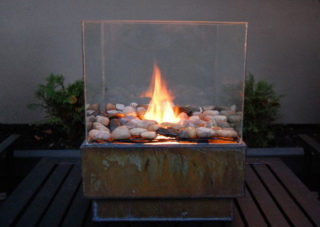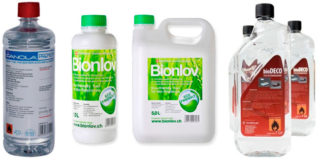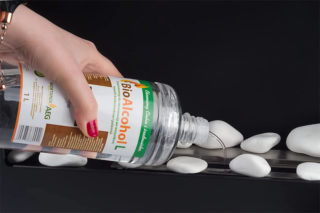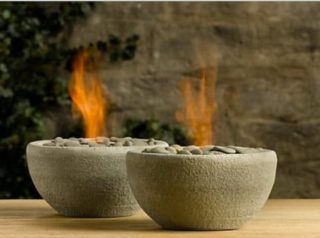It is impossible to use traditional fuel for a fireplace in apartments of multi-storey buildings, as this is prohibited by the rules of operation of residential buildings. There is a high probability of fire and smoke, and openings under the chimney can significantly weaken the supporting structures. A biofuel fireplace is an excellent alternative to products using wood and electricity. Thanks to this modern, beautiful and efficient device, city dwellers can enjoy the game of real flame and sounds that reliably imitate the crackling of burning branches.
Biofuel Composition
Biofuel for a fireplace is a synthetic composition obtained by chemical processing of raw materials of animal and vegetable origin. Product production is carried out by fermentation of organics in which sugar is present: wheat, cane sugar, sugar beets, potatoes, seaweed. As a result of the manipulations at the output, ethanol is obtained. To achieve the effect of a bonfire flame, environmentally friendly additives are added to it, giving the fire a characteristic color.
In appearance, the fuel is a neutral color gel. And in composition - a solution in which 95% of pure ethanol, and 5% - water and additives that ensure combustion stability and flame naturalization. Alcohol is denatured, since the sale of alcohol outside specialized retail outlets is prohibited by international treaties and domestic laws.
Pure denatured ethanol is odorless. To meet the tastes of consumers, manufacturers add flavors to it that, when burning fuel, create the smell of needles, coal, firewood or light smoke. Sounds naturally mimic crystals of sea salt added to the gel.
Depending on the design of the source, the combustible solution is placed in banks in the appropriate recesses or poured into the tank through which it is distributed over the burners. On average, one liter of refueling is enough for 2-3 hours of operation of the device with produced thermal energy of 1-2 kW / h.
Varieties of biofuels and features
On sale are various types of environmental fuels for decorative homes.
A biofuel fireplace can work on such fuel:
- Biogas. The raw material for production is organic waste, which releases rot products into the air. Using a special system, gas is collected, purified and treated in a special way for further use.
- Bioethanol It is an analogue of fuel for internal combustion engines. The liquid is produced by hydrolysis of wood, straw and other materials with a high content of cellulose. Another type of production technology is the fermentation of carbohydrates, which are found in foods with a high concentration of starch and sugar.
- Biodiesel In the manufacture of oils of rapeseed, coconut, palm, soy, animal fats.
When purchasing biological fireplace fuel, you need to make sure that it is suitable for the previously purchased product.
Advantages and disadvantages
Like any substance used in everyday life, biofuel for a biofireplace has its pros and cons.
Among the advantages include:
- the absence of harmful emissions during combustion, the need to equip the chimney and exhaust;
- ease of transportation and storage;
- ease of maintenance of equipment, lack of ash and ash;
- creating a reliable effect of burning logs;
- affordable cost;
- the possibility of making with your own hands;
- almost complete fire safety.
A liquid fuel fireplace has its drawbacks:
- insufficient power for high-quality heating of rooms with a large area, limited radius of action;
- it is not recommended to leave a working device unattended, since the possibility of interference by children, animals or people with inadequate psyche should be taken into account;
- the inability to refuel without stopping the combustion process and complete cooling of the device;
- you can use only special lighters for ignition, the use of matches or burning paper is not allowed;
- restrictions on the place of storage - you can not keep containers near heating appliances and in places accessible to children and people with mental disabilities.
Given the above factors, it can be concluded that a biofireplace is more an element of luxury and interior than a heating device. As an element of additional heating, it can come in handy during the off-season and during severe cold weather.
The product lacks electric spirals, a fan, a furnace, and a chimney, so designers have the opportunity to experiment with shapes and sizes. In addition to the classic floor models of the corner and wall type, decorative table and wall fireplaces are produced. This is an interesting solution for offices and modern apartments decorated in techno or modern style. Interesting products are an element of the image, while creating a feeling of comfort and coziness.
Fuel consumption for biofireplaces
Fuel for bio-fireplaces is produced on all continents, but Brazil is the leader, where there is an almost unlimited amount of resources for the manufacture of the gel. There are factories in Russia that are gradually reaching the required capacity in order to fulfill the task of import substitution of expensive products. Its price is quite high, so as not to reckon with this factor. Depending on the brand, it varies between 500-1000 rubles per liter. The liquid goes on sale in plastic canisters with a capacity of 1-5 liters.
Manufacturers announce such fuel consumption:
- Kratki BioDECO (Poland) - 250 ml / h;
- InterFlame (Russia) - 300 ml / h;
- Fanola (Germany) - 270 ml / h;
- BioKer (Russia) - 250 ml / h;
- Vegeflame (France) - 220 ml / h;
- Bionlov (Switzerland) - 225 ml / h;
- Bioteplo slimfire (Italy) - 240 ml / h.
The duration of fuel combustion in the fireplace depends on the volume of the filling tank. The larger it is, the longer the device will work. Modern models are able to maintain combustion for up to 20 hours with a full charge of 5000 ml.
Most products have a function for adjusting the flame intensity. This allows you to set low or high temperature, save fuel or burn it in high mode to achieve the desired effect.
Self-made biofuels
Self-made biofuels for a home fireplace can save money.
For work, such materials and devices will be required:
- Medical alcohol. Sold without a prescription in all pharmacies in 100 ml vials. The price is between 50-70 rubles apiece.
- Refined petrol for refueling lighters. You can find it at almost any point of sale that sells tobacco products. The cost of the spray can vary between 100-120 rubles per 125 ml. It is better to take gasoline brand Zippo, which is of high quality and good compatibility with alcohol.
- Flavoring.Essential oils, which can also be found in pharmacies, are well suited. A solution with a favorite smell is selected. It can be pine, juniper, eucalyptus, lemon or grapefruit. For 100 ml of the composition, 5-10 drops of oil are enough.
- Sea salt. The goods are sold in supermarkets in packages of 1 kg. It is recommended to use coarse and finely ground salt, as crystals of different sizes produce quiet and loud sounds characteristic of burning natural wood.
- A plastic water bottle with a capacity of 1000-5000 ml, depending on the planned volume of the finished liquid.
Mixing the composition is best done in plastic or aluminum containers.
In the manufacture of biofuels, combustible substances and volatile compounds are used, therefore, the following safety measures must be observed:
- work in a well-ventilated area;
- use rubber gloves and safety glasses;
- have rags on hand to collect the spilled liquid and clean water for washing the skin and mucous membranes.
After cooking, pour the mixture into the bottle and close the lid tightly. The capacity must be signed in such a way that no one can use its contents for other purposes. The inscription should be large and catchy, so that a visually impaired person can read it.
Operational moments
Operating conditions of a biofireplace:
- refueling is possible only after the product has completely cooled down;
- if the liquid spills onto the floor, immediately wipe it off and wash the coating with a soapy solution;
- Do not store a container with fuel near the fireplace;
- Before the planned downtime of the equipment, it is necessary to completely burn out the fuel in it;
- refueling is allowed only to the level that is set for each model.
When these rules are followed, the fireplace will last for many years, delighting the owners with an original exotic glow and warmth.









